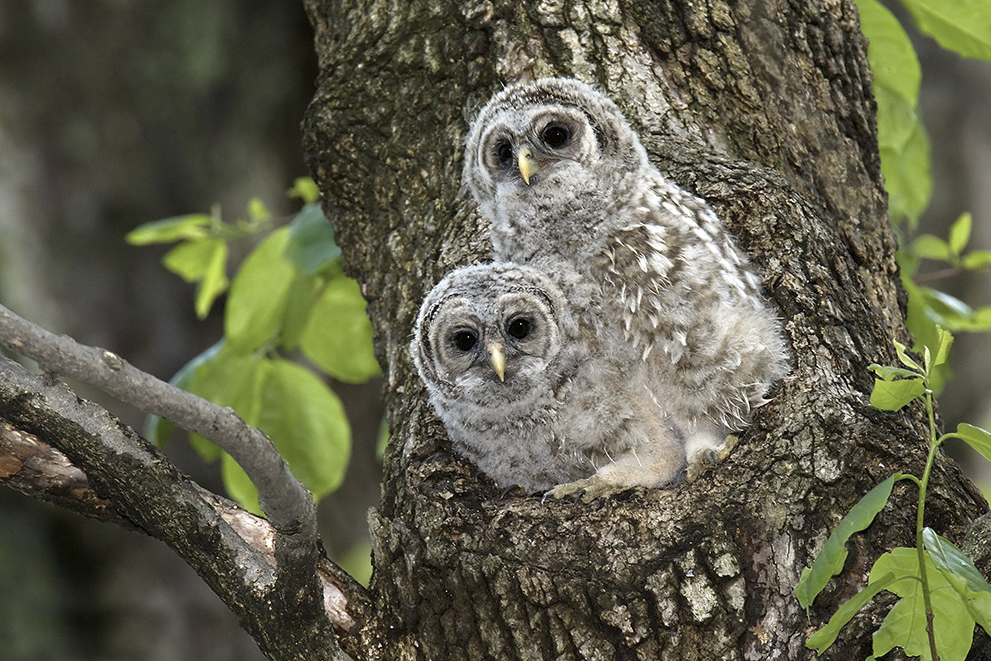The most immediate threat to the existence of the Northern spotted owl doesn’t carry an axe.
It doesn’t wear plaid, work in a sawmill, or drive a pickup truck featuring a faded yellow bumper sticker reading “Save a logger—kill an owl.”
Instead, 25 years removed from the Timber Wars of the early ’90s, which anecdotally pitted hemp-wearing environmentalists against grizzled loggers, the spotted owl is challenged by a foe hardly distinguishable from itself. That’s because it’s another owl. Specifically, the barred owl, an invasive species that has moved into Pacific Northwest forests and wrought havoc on their native cousins.
“If we don’t do something about the barred owl, we’re going to lose the Northern subspecies of the spotted owl,” U.S. Fish and Wildlife Service’s Robin Bown says. “I wouldn’t have told you that 10 years ago.”
But make no mistake: Habit loss, not another bird, first pushed the spotted owl to the brink of extinction.Llike the loggers before them, the barred owls pose an existential threat to the spotted variety, and drastic action may be needed.
Drastic action such as killing them by the thousands.
As long as commercial logging has been in Washington, crews of men with saws and axes have prized the old-growth and complex-growth forests the spotted owl calls home. And the owl has paid, losing over 90 percent of its population since European settlement, recent studies show.
But since the Northern spotted owl was listed as a threatened species under 1990’s Endangered Species Act, and the subsequent Northwest Forest Plan developed to meet the needs of both loggers and birds, habit loss has either plateaued or gone as expected. Yet spotted owls have continued to disappear at a fantastic rate. This is where the barred owl comes in.
Estimates on the total number of spotted owls in Washington state are, like the bird itself, elusive, but spotted-owl study areas indicate the scope of their demise. In the three study areas in Washington actively monitored by state and federal agencies, spotted-owl populations have declined between 4.7 percent and 8.4 percent a year over the past 20 years. In one Cle Elum study area, of 77 historical spotted-owl territories only 11 were found occupied in 2015. Of those 11 sites, seven contained breeding pairs of owls, with just three breeding pairs spotted with young. In an Olympic Peninsula study area, the probability of finding a spotted owl in a range deemed a “known spotted-owl site” dropped 75 percent from 1995 to 2013.
Ken Wiersema, president of the Olympic Peninsula Audubon Society, says it’s been “several” years since any member of the society has seen or heard a spotted owl during the society’s annual bird census. “They’re still out there,” Wiersema says. “But there’s no question they’re in decline.”
In contrast, the barred-owl population has consistently risen all over Washington, Bown says. Deforestation, highway construction, and changing climate allowed the barred owl, a non-native species, to move east sometime in the mid-20th century. And the adaptable owl has thrived—increasingly, Bown says, even in old- and complex-growth forests. In that Cle Elum survey area with 11 spotted owls, 173 barred owls were identified—an incredible number for a bird likely not even in the area 50 years ago. Wiersema says the same is true on the peninsula. “I could take you out this afternoon and probably find a barred owl,” Wiersema says.
A more generalized and aggressive predator, the barred owl out-competes the spotted owl for territory and food, Bown says—so much that, according to a 2016 Washington Department of Fish and Wildlife report, the spotted owl “could become functionally extirpated in Washington” without management that “effectively addresses competitive interactions with the barred owls.”
“Effectively addresses” could mean a lot of things, but in recent years it’s meant killing barred owls on sight in certain areas.
In 2013, the USFWS and the U.S. Geological Survey implemented the Barred Owl Removal Experiment. Based on a previous small-scale experiment in California that showed some success, the study identified four areas—one in Washington, one in California, two in Oregon—where barred owls had invaded spotted-owl habitat. Each study area was split in two, with one side serving as a treatment range, the other as a control range. Barred owls from the treatment range were then shot.
Since last fall, 123 barred owls have been killed in Washington’s study area. While it’s too early to tell for Washington, Bown says that the BORE study has shown success in helping spotted-owl numbers. “Several trend-analysis reports were issued for the spotted owl in California,” Bown, the study’s co-lead biologist, says. “The only place the spotted owl is not in decline is in the Green Diamond [California] treatment area.” She expects the Washington study area will show similar results, suggesting that with the barred owl gone from their habitat, spotted owls can survive.
Of course, simply conducting the Barred Owl Removal Experiment is a long way from saving the spotted owl. Joseph B. Buchanan, with the Washington Department of Fish and Wildlife, says that if the results of barred-owl reduction in California are found in Washington, more questions will arise than answers—for example, will the public think it acceptable to implement a spotted-owl plan that may mean shooting barred owls on a larger scale, possibly indefinitely? “It really comes down to the cost and societal acceptance of this strategy,” Buchanan says. “This is something that will possibly need to be done as long as we have spotted owls.”
Both Buchanan and Bown understand that any long-term survival strategy for the spotted owl that may include the continued shooting of barred owls will be a tough sell. PETA has denounced the Barred Owl Removal Experiment. And though a few Audubon Societies in the state have come out in support of the experiment, widening the scope from experiment to standard operating procedure is a different matter entirely. “Clearly it’s not a long-term solution,” says Jennifer Syrowitz, conservation manager for the Society’s Washington chapter. “I’m quite confident the Audubon would make this statement.”
Tony Angell, Lake Forest Park resident and author of The House of Owls, says he has seen the barred owl’s aggressive behavior first-hand—not toward spotted owls, but toward a family of Western screech owls that had nested in his backyard for decades.
“After two years of pretty intense barred-owl presence, the screech owls were gone,” Angell says. He understands the plight of the spotted owl, but cautions against any long-term strategy that doesn’t address what he sees as still the biggest problem the elusive owl faces. “I’m convinced that if old-growth forests had still been around, the story would have been different,” he says, emphasizing the habitat loss that pushed the spotted owl to the brink in the first place. “Is killing 3,500 barred owls going to be the salvation of the species? I doubt it.”
Both Bown and Buchanan emphasize that larger-scale killing of barred owls is just one of many possible outcomes of the four-year Barred Owl Removal Experiment. And both sympathize with others who find BORE, or further killing, hard to stomach.
Still, Bown wonders if, because human decisions both spurred the demise of the spotted owl and allowed the barred owl to fly west over time, it’s not humans’ responsibility to try to find a way to protect a storied native species.
“I believe we are responsible for trying to take care of our mistakes,” she says. “Sometimes we mess it up, but that’s part of why we’re doing this study. We’re trying to figure out what helps.”







